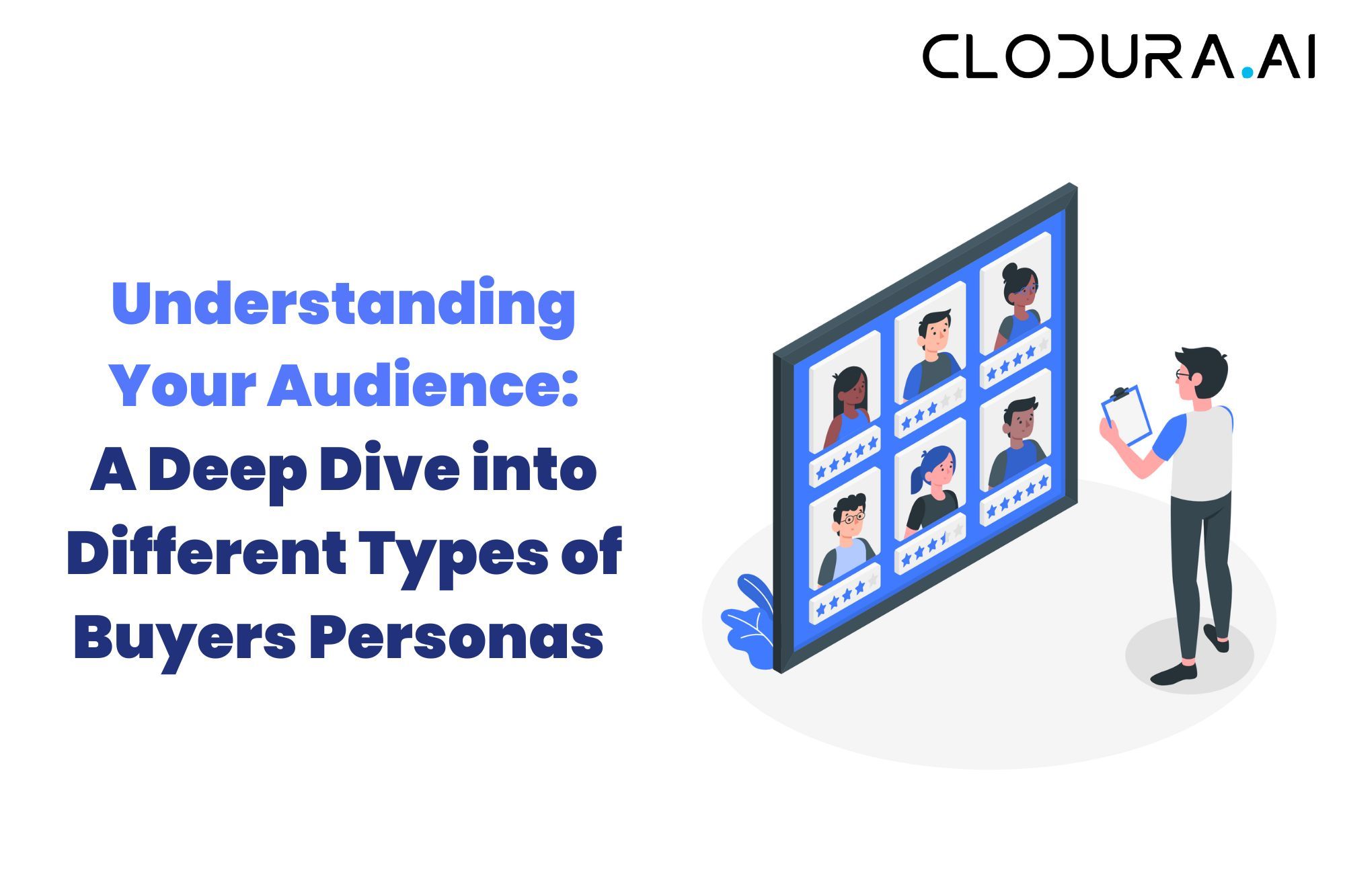Are you struggling to connect with your target audience?
Understanding the different types of buyer personas can help you tailor your marketing strategies for maximum impact. In this deep dive into buyer personas, we will explore the various characteristics and motivations that influence purchasing decisions. Each buyer persona represents a distinct segment of your target market, with unique needs, preferences, and behaviors. By creating detailed buyer personas, you can gain valuable insights into what drives your customers' decision-making process.
Whether you're a B2C or B2B business, knowing your audience on a deeper level allows you to refine your marketing messages, product offerings, and customer experience. From demographics and psychographics to pain points and goals, we'll cover everything you need to know to create effective buyer personas.
Join us as we delve deep into the minds of your potential customers, uncovering the key factors that drive their purchasing decisions. With this newfound understanding, you can position your brand as the solution they've been searching for. Unlock the power of buyer personas and watch your conversions soar. Let's get started on understanding your audience like never before.
Understanding Your Audience: A Deep Dive into Different Types of Buyers Personas
Are you struggling to connect with your target audience? Understanding the different types of buyer personas can help you tailor your marketing strategies for maximum impact. In this deep dive into buyer personas, we will explore the various characteristics and motivations that influence purchasing decisions.
Each buyer persona represents a distinct segment of your target market, with unique needs, preferences, and behaviors. By creating detailed buyer personas, you can gain valuable insights into what drives your customers' decision-making process.
Whether you're a B2C or B2B business, knowing your audience on a deeper level allows you to refine your marketing messages, product offerings, and customer experience. From demographics and psychographics to pain points and goals, we'll cover everything you need to know to create effective buyer personas.
Join us as we delve deep into the minds of your potential customers, uncovering the key factors that drive their purchasing decisions. With this newfound understanding, you can position your brand as the solution they've been searching for.
Unlock the power of buyer personas and watch your conversions soar. Let's get started on understanding your audience like never before.
Why understanding your audience is crucial
In today's highly competitive marketplace, it's more important than ever to truly understand your audience. Consumer behaviors and preferences are constantly evolving, and businesses that fail to keep up will find themselves left behind.
By understanding your audience on a deeper level, you can gain insights into what motivates them to make purchasing decisions. This knowledge allows you to fine-tune your marketing efforts, ensuring that your messages resonate with your target market. Without a thorough understanding of your audience, your marketing campaigns may fall flat, wasting both time and resources.
Types of buyer personas
Each buyer persona represents a distinct segment of your target market, with unique needs, preferences, and behaviors. Let's explore some of the most common types of buyer personas:
1. The Researcher:
This persona is characterized by their desire to gather as much information as possible before making a purchase. They value in-depth research, comparing options, and reading reviews before committing to a decision. For this persona, providing detailed product information, customer reviews, and expert opinions can be highly influential.
2. The Bargain Hunter:
Bargain hunters are motivated by finding the best deals and discounts. They are price-sensitive and will carefully compare prices across different brands or retailers. Offering exclusive discounts, limited-time promotions, or loyalty programs can appeal to this persona.
3. The Trendsetter:
Trendsetters are early adopters who are always on the lookout for the latest and greatest products or services. They value innovation, uniqueness, and being ahead of the curve. To capture the attention of trendsetters, focus on highlighting the cutting-edge features or benefits of your offerings.
4. The Problem-Solver:
This persona is motivated by addressing a specific pain point or problem. They are actively searching for solutions that can alleviate their frustrations. To appeal to problem-solvers, emphasize how your product or service can solve their specific challenges.
Creating buyer personas
Now that we've covered the different types of buyer personas, let's dive into how to create them effectively.
1. Conduct thorough research:
Start by gathering data on your current customers. Utilize surveys, interviews, and analytics tools to collect information about their demographics, preferences, pain points, and goals. The more data you have, the more accurate and detailed your buyer personas will be.
2. Identify common characteristics:
Look for patterns and similarities among your customers. Group them into segments based on shared characteristics such as age, gender, income, interests, and behaviors. These segments will form the basis for your buyer personas.
3. Give them names and stories:
To make your buyer personas more relatable, give them names and create fictional stories around their lives. This helps you visualize their motivations and thought processes, making it easier to tailor your marketing messages accordingly.
Researching and gathering data for buyer personas
When it comes to creating accurate buyer personas, thorough research is key. Here are some effective methods for researching and gathering data:
1. Surveys:
Conduct online surveys to gather insights directly from your target audience. Ask questions about their demographics, preferences, pain points, and motivations. Offer incentives to encourage participation and ensure a higher response rate.
2. Interviews:
Schedule one-on-one interviews with your existing customers. Dive deep into their experiences, challenges, and motivations. This qualitative data can provide valuable insights that may not be captured in surveys.
3. Analytics tools:
Utilize web analytics tools to gather data on user behavior, such as click-through rates, bounce rates, and conversion rates. This data can help you identify patterns and trends among your website visitors.
Analyzing and segmenting buyer personas
Once you have gathered the necessary data, it's time to analyze and segment your buyer personas. Here's how to do it effectively:
1. Identify common characteristics:
Look for commonalities among your customers. Group them based on demographics, behaviors, interests, and pain points. This will allow you to create distinct buyer personas that accurately represent different segments of your target market.
2. Prioritize personas:
Determine which buyer personas are most valuable to your business. Focus your marketing efforts on these personas, as they are likely to generate the highest return on investment.
3. Refine and update:
Buyer personas are not set in stone. As consumer behaviors evolve, so should your personas. Regularly review and update your buyer personas to ensure they remain accurate and relevant.
Using buyer personas in marketing campaigns
With your buyer personas in hand, it's time to put them to work in your marketing campaigns. Here's how to leverage your buyer personas effectively:
1. Tailor your messaging:
Craft marketing messages that resonate with each buyer persona. Highlight the specific benefits and features that are most likely to appeal to their motivations and pain points.
2. Choose the right channels:
Determine which marketing channels your buyer personas are most likely to engage with. Focus your efforts on those channels to maximize your reach and impact.
3. Personalize the customer experience:
Use your buyer personas to create personalized experiences for your customers. From targeted email campaigns to customized landing pages, personalization helps build stronger connections and increases conversion rates.
Common mistakes to avoid when creating buyer personas
While creating buyer personas can be immensely valuable, there are some common mistakes to avoid:
1. Making assumptions:
Relying on assumptions or stereotypes can lead to inaccurate buyer personas. Always back up your findings with data and research.
2. Neglecting quantitative data:
While qualitative data provides important insights, don't overlook the power of quantitative data. Combine both types of data to create a more comprehensive view of your buyer personas.
3. Overcomplicating personas:
Keep your buyer personas concise and focused. Avoid including unnecessary details that may dilute their impact.

Examples of successful buyer persona implementations
To inspire you in creating your own buyer personas, here are some examples of successful implementations:
1. HubSpot:
HubSpot uses detailed buyer personas to create personalized content and targeted marketing campaigns. By understanding their audience's pain points and goals, they are able to provide valuable solutions and build strong relationships with their customers.
2. Nike:
Nike has effectively targeted different buyer personas with their product offerings. They have distinct lines for professional athletes, casual runners, and fashion-conscious individuals, each tailored to the specific needs and preferences of their target audience.
3. Airbnb:
Airbnb has created buyer personas based on the different types of travelers they cater to. By understanding the motivations and preferences of each persona, they are able to offer personalized recommendations and experiences that resonate with their audience.
To Warp Up,
Understanding your audience on a deep level is essential for any business looking to succeed in today's competitive landscape. By creating detailed buyer personas, you can gain valuable insights into what drives your customers' decision-making process. Use these insights to refine your marketing messages, product offerings, and customer experience. Unlock the power of buyer personas and watch your conversions soar.
FAQs
Q: What is a buyer persona?
A buyer persona is a detailed, semi-fictional representation of your ideal customer, based on market research and real data.
Q: Why are buyer personas important for businesses?
Buyer personas help businesses understand their target audience, tailor marketing strategies, and improve overall communication for more effective engagement.
Q: How do you create a buyer persona?
Creating a buyer persona involves researching customer demographics, behaviors, motivations, and preferences, and then synthesizing that information into a comprehensive profile.
Q: What role do buyer personas play in marketing campaigns?
Buyer personas guide marketers in crafting personalized messages, choosing appropriate channels, and creating content that resonates with specific audience segments.
Q: Can buyer personas change over time?
Yes, buyer personas should be regularly updated to reflect changes in market trends, customer behaviors, and business goals, ensuring continued relevance and effectiveness.


